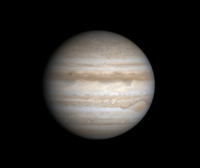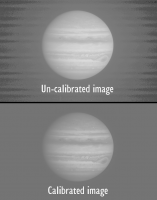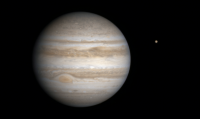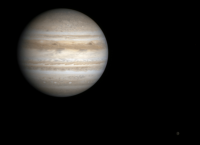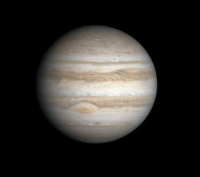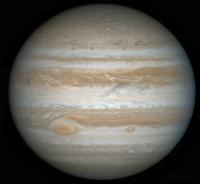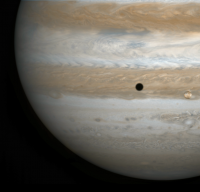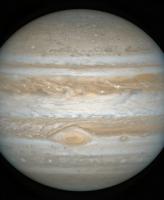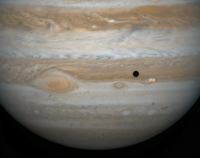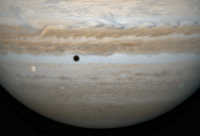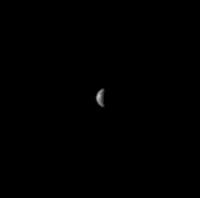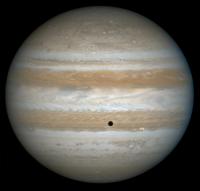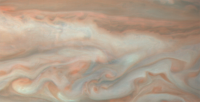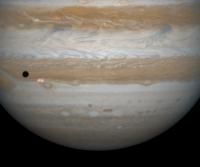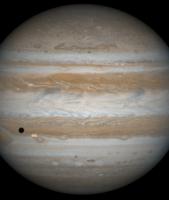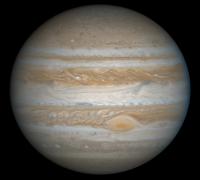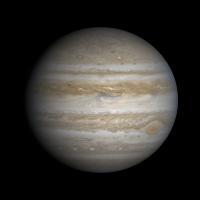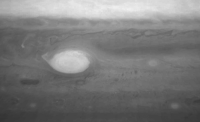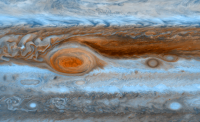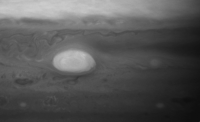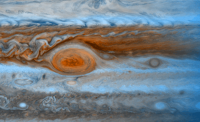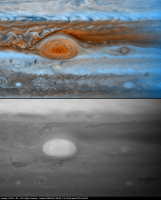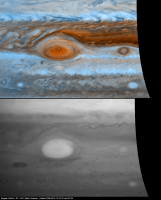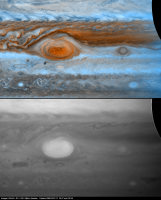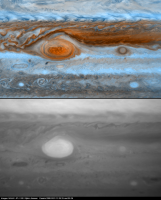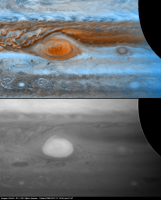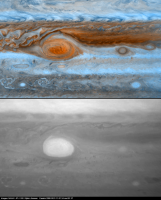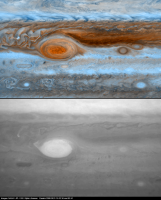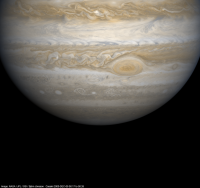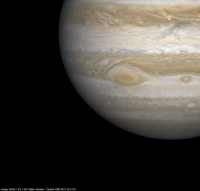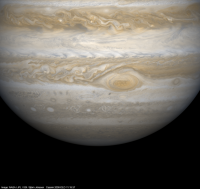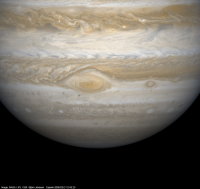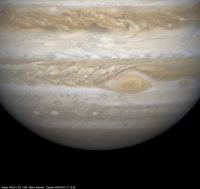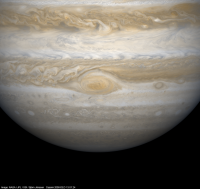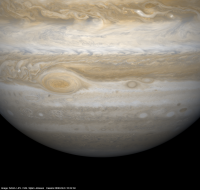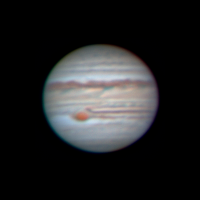Printable Version of Topic
Click here to view this topic in its original format
Unmanned Spaceflight.com _ Jupiter _ Processed Cassini Jupiter Images
Posted by: Bjorn Jonsson Aug 3 2005, 10:26 PM
Now that I have downloaded all of the PDS formatted Cassini Jupiter images (and actually all of the Saturn images too) I have been experimenting with processing calibrated versions of them:
http://www.mmedia.is/bjj/misc/css_stuff/images/cb1grnbl1_proc.jpg
http://www.mmedia.is/bjj/misc/css_stuff/images/io_transit_color_mosaic.jpg
The first one is simply a global view composed from CB1 (red), GRN and BL1 filtered images with the color balance adjusted to make it more realistic and with some sharpening applied to the image. This is a preliminary version, it looks very bluish at the limb due to Jupiter's rotation (I preferred this to color fringing at the center of Jupiter's disk). Later I plan to fix this by rotating the images in 3D space.
The second one is a reprocessed version of the well known Io transit image but with the addition of the north polar region - since this is a preliminary version some seams may be visible. Later this may turn into a global mosaic. The color balance is also improved. The 'official' image seems to have been composed from CB2, (CB2+BL1)/2 and BL1 filtered images (only CB2 and BL1 images are available). Using CB2 as red makes the belts too reddish if you want whitish zones. To fix this I used a synthetic CB1 image created from a linear combination of the CB2 and BL1 images. Needless to say I also used a synthetic green image.
Now the plan is to do a big cylindrical map of Jupiter followed by an even bigger one of Saturn.
Posted by: Sunspot Aug 3 2005, 10:39 PM
http://www.mmedia.is/bjj/misc/css_stuff/images/cb1grnbl1_proc.jpg
http://www.mmedia.is/bjj/misc/css_stuff/images/io_transit_color_mosaic.jpg
The first one is simply a global view composed from CB1 (red), GRN and BL1 filtered images with the color balance adjusted to make it more realistic and with some sharpening applied to the image. This is a preliminary version, it looks very bluish at the limb due to Jupiter's rotation (I preferred this to color fringing at the center of Jupiter's disk). Later I plan to fix this by rotating the images in 3D space.
The second one is a reprocessed version of the well know Io transit image but with the addition of the north polar region - since this is a preliminary version some seams may be visible. Later this may turn into a global mosaic. The color balance is also improved. The 'official' image seems to have been composed from CB2, (CB2+BL1)/2 and BL1 filtered images (only CB2 and BL1 images are available). Using CB2 as red makes the belts too reddish if you want whitish zones. To fix this I used a synthetic CB1 image created from a linear combination of the CB2 and BL1 images. Needless to say I also used a synthetic green image.
Now the plan is to do a big cylindrical map of Jupiter followed by an even bigger one of Saturn.
Beautiful images.
Where are you finding the Jupiter Images?
Posted by: Bjorn Jonsson Aug 3 2005, 10:53 PM
All of the PDS formatted Cassini images (more than 60,000 !) are available here:
http://pdsimg.jpl.nasa.gov/data/cassini/cassini_orbiter
The Jupiter images taken near closest approach are on volume coiss_1004.
Posted by: tedstryk Aug 3 2005, 11:06 PM
I came across a view like the one of Io but with Ganymede. Methinks I must get around to processing it soon ![]()
Posted by: Toma B Aug 4 2005, 02:24 PM
Bjorn Jonsson what program can I use for wieving *.IMG files??? ![]()
Posted by: Toma B Aug 4 2005, 02:27 PM
by the way those images look great!!! ![]()
Posted by: djellison Aug 4 2005, 02:32 PM
Toma B - search this forum for ' img2png ' - it's Bjorns tool to convert an IMG file into a 16 bit PNG file - which is readable by just about any program
Doug
Posted by: tedstryk Aug 4 2005, 06:36 PM
Here is the best I could do with the ganymede image...the raws are horribly underexposed. It is composed of UV3/P60 + ((GRN/CL1+GRN/CL2+GRN/P0+GRN/P120)/4) + P60/MT2
The images were, as I said, horribly underexposed. Add to that the problem of MT2 making a horrible red filter. Hopefully some more cleaning can make a picture out of this yet!
http://img275.imageshack.us/my.php?image=casgancol0j7he.jpg
Posted by: djellison Aug 4 2005, 07:24 PM
ted - what range are the source images in?
Doug
Posted by: tedstryk Aug 4 2005, 10:03 PM
The sources are:
N1357128733_1.IMG
N1357128799_1.IMG
N1357128865_1.IMG
N1357128931_1.IMG
N1357129012_1.IMG
N1357129078_1.IMG
Posted by: djellison Aug 5 2005, 12:07 PM
I think they must have had some sort of 'Red-Filter Awareness' campaign once they left the Jupiter region - nothing..arhghgh
For instance, look at this..
N1357035094_1.IMG
N1357035048_1.IMG
And they made THIS
http://photojournal.jpl.nasa.gov/catalog/PIA02879
???
Doug
Posted by: tedstryk Aug 5 2005, 06:27 PM
Perhaps this was done in sympathy with Voyager's red-less ISS ![]()
Posted by: scalbers Aug 22 2005, 06:45 PM
Might be interesting to redo the Cassini global cylindrical movie of Jupiter in color. The released version was relatively low in resolution, yet the original was at higher resolution judging from one of the still images released. This is the 2-D interpolated movie I'm referring to.
Posted by: alan Sep 11 2005, 05:16 AM
Jupiter's Clouds from Cassini
http://antwrp.gsfc.nasa.gov/apod/ap050911.html
Posted by: Bjorn Jonsson Sep 11 2005, 07:24 PM
Here is a heavily processed mosaic of the Great Red Spot (GRS) I just finished. It is created from raw (PDS) images obtained close to the time of closest approach:
http://www.mmedia.is/bjj/images/jupiter_cassini_grs_caption.jpg
This is a mosaic of several CB2/blue images with the CB1 (red) and green images created using linear combinations of the CB2 and blue images. The effects of varying illumination across the images have been removed, the images reprojected to simple cylindrical projection and then back to perspective projection showing the GRS from directly above, thus showing the true shape of the spot.
The gaps are areas for which the only available data was obtained one rotation (aproximately 10 hours) after the images I used. Due to cloud motions these images cannot be used without 'cheating'.
Posted by: Ian R Sep 12 2005, 01:15 AM
Awesome work, Bjorn! ![]()
Posted by: scalbers Nov 21 2009, 07:00 PM
This has in fact been done as a part of a http://svs.gsfc.nasa.gov/vis/a010000/a010400/a010477/index.html. The Jupiter animation looks great at higher resolution. The next thing I'm checking into is whether this movie from the Cassini Dec 2000 flyby is available in a stand alone version. The full 1.6 GB SOS presentation where the Cassini animation is embedded can be downloaded ftp://public.sos.noaa.gov/extras/largest/.
Posted by: Ian R Dec 15 2009, 03:28 PM
Now, I'm usually a RAW images man - I like putting together vistas that were captured in the very recent past, and 'hot off the press' if you like.
However, I've finally got around to playing with Bjorn's awesome IMG2PNG utility and have calibrated some early Cassini views of Jupiter (the difference between the calibrated and non-calibrated images is quite staggering). Due to the lack of any RED filters, the following view was constructed using a synthetic red (sort of GREEN minus BLUE, in effect). I'm really pleased with the result:
Jupiter, as it appeared to Cassini on the 14th of October, 2000
Thanks Bjorn!
Posted by: Ian R Dec 15 2009, 03:40 PM
A comparison of an image from the PDS, before and after the IMG2PNG treatment. I've brightened both views quite considerably in order to make visible all of the crud that the calibration process removes:
Posted by: Ian R Dec 15 2009, 04:19 PM
Last of all, for the time being, a classic view of the Jovian giant, with the GRS emerging from the terminator:
(October 13th)
Posted by: Ian R Dec 18 2009, 09:41 AM
Here's a 4-frame NAC mosaic from the 10th December 2000:
(Edit: Replaced the original with a better version)
Posted by: Ian R Dec 18 2009, 02:57 PM
...and a rather pretty view of Io transiting the Jovian disc earlier the same day (10th):
Posted by: tedstryk Dec 18 2009, 03:15 PM
Wow, that one is exquisite!
Posted by: Ian R Dec 18 2009, 03:50 PM
Thanks Ted! ![]() It took me a little while to figure out how to blend together the Io-centric and Jupiter-centric versions of this composite, but I got there in the end without having to resort to the Paint Shop Pro lasso tool!
It took me a little while to figure out how to blend together the Io-centric and Jupiter-centric versions of this composite, but I got there in the end without having to resort to the Paint Shop Pro lasso tool!
Anyway, here's a two-frame mosaic from the 12 of December, with an additional enhancement to bring the limb out of the gloom slightly:
Posted by: machi Dec 18 2009, 04:02 PM
Very nice images!
Jupiter is one of the most photogenic objects in solar system.
Image with Io is magnified or is it mosaic (is bigger than Cassini CCD)?
Posted by: ugordan Dec 18 2009, 06:04 PM
It sure is! It's also tough to work with unless you have a rapid-fire camera, and Cassini's sure don't fit that bill. Great work on the images, Ian, they look very close in color to official images. Here are a couple of my recent processings:
http://www.fileden.com/files/2007/9/14/1431389/Ganymede_1.jpg http://www.fileden.com/files/2007/9/14/1431389/Ganymede_2_2.jpg http://farm4.static.flickr.com/3060/2931795524_84b980bb5c_o.png
http://farm4.static.flickr.com/3039/2942210318_9baf530b48_o.jpg http://www.flickr.com/photos/ugordan/4093032545/
And an animated gif:
http://www.flickr.com/photos/ugordan/3655667658/
Posted by: Paolo Dec 18 2009, 08:22 PM
wow! I set the image of Ganymede transiting as the wallpaper of my mobile phone!
Posted by: nprev Dec 18 2009, 08:58 PM
Knockout work again, Ian & Gordan! What amazing vistas.
Posted by: Ian R Dec 19 2009, 10:00 AM
Good grief Gordan - you just keep on coming up with the goods! ![]() That animation is the definition of awesome (well, according to my dictionary it is, anyway).
That animation is the definition of awesome (well, according to my dictionary it is, anyway).
Here's a little something I knocked-up this morning:
(Dec 12, 2000)
Posted by: nprev Dec 19 2009, 10:05 AM
You definitely just coined the motto of all you imagesmiths, and that of this site...
Posted by: Ian R Dec 19 2009, 10:55 AM
Nice one Nprev - maybe Doug could have some T-shirts made up with that emblazoned across the front...
Here's a Europa transit from the same day as before (Dec 12th 2000):
Posted by: Ian R Dec 19 2009, 11:00 AM
Good point Machi. I usually work with images at 400% of their original size in order to minimize any alignment errors. In that instance, I neglected to reduce the final composite to its normal dimensions. However, these Cassini pictures are of such quality that at 200% tghey still look very crisp and presentable.
Posted by: tedstryk Dec 19 2009, 04:40 PM
For a different perspective, here is a Galileo/groundbased fusion taken by Galileo from September 13, 2000, as Cassini was beginning its approach.
Here is an larger view of Ganymede (for which much better Galileo data was available).
I have long had plans to work with the Cassini data, but with Eli's arrival those plans are shelved for now.
Posted by: Ian R Dec 19 2009, 11:22 PM
A vista of Jupiter and Io from the 10th of December 2000. The teardrop-shaped white cloud just below Io later merged with another white spot and metamorphosed into Red Spot Junior (if memory serves):
Posted by: tedstryk Dec 19 2009, 11:26 PM
Beautiful image, although the background could use some cleaning.
Posted by: Ian R Dec 19 2009, 11:46 PM
Thanks for the pointer, Ted - I've uploaded a corrected version.
And let me belatedly congratulate you on the birth of your son. Wonderful news! ![]()
Posted by: tedstryk Dec 20 2009, 04:22 AM
Thanks!
As for the image background, if I had a dollar for every time I've done that and had to covertly switch the image out, I'd be a rich man.
Posted by: tedstryk Dec 20 2009, 09:56 PM
Here is a closeup detail from January 1, 2001, again from Galileo.
Posted by: Ian R Dec 21 2009, 12:39 PM
Nice one Ted. Here's another Jupiter-Io pairing that I prepared a little earlier...
Posted by: ugordan Dec 21 2009, 12:50 PM
Hey, nice one! I don't recall seeing that Io - GRS arrangement when I was hunting for Kodak shots.
Posted by: scalbers Mar 30 2012, 04:42 PM
And more specifically the individual frames for the Jupiter animation can be found here:
http://svs.gsfc.nasa.gov/vis/a000000/a003600/a003610/frames/3601x1801_2x1_30p/
This is probably the best version for this Cassini Jupiter animated dataset that I've come across. Now we just have to make an animation file for this (e.g. an MP4).
Steve
Posted by: Bjorn Jonsson Jul 10 2012, 02:20 PM
This is a 2x2 mosaic of Cassini images obtained on November 30, 2000 from a distance of 30 million km:
The majority of global images of Jupiter includes the Great Red Spot (GRS) and in most of these the GRS is near the center of the disc or a bit towards the terminator. This one is an exception and shows the GRS near the limb.
CB2 (near infrared) and BL1 (blue) images were used. At this time Cassini wasn't taking green filtered images so I created a synthetic green image as GRN = 1.126959 x (0.481 x CB2 + 0.519 x BL1). I also created a synthetic red (CB1) image as CB1 = 1.106251 x (0.774 x CB2 + 0.226 x BL1) using CB1, GRN and BL1 images obtained at a greater range a few weeks earlier as a guide. I then altered the color balance slightly to make the bright zones more whitish and less yellowish (actually the real color of the zones might be slightly yellowish so in retrospect maybe I should have omitted this processing step).
The images were reprojected to simple cylindrical projection, mosaiced and then rendered using the viewing geometry Cassini had when it took one of the BL1 images. The final step was to sharpen the resulting image slightly.
Posted by: Bjorn Jonsson Jun 11 2019, 07:41 PM
The recent Great Red Spot (GRS) 'disruption' has been very interesting. Anticyclonic spots have been moving towards the GRS from the east, entering the red spot hollow and then moving around the GRS. This has sometimes managed to distort the apparent shape of the GRS. This is especially noticeable in methane band images (these images are indicative of cloud altitudes with bright areas in these images being high altitude clouds or hazes). Red blades/flakes also appear to separate from the GRS when this happens.
I took a look at the Cassini Jupiter images because I vaguely remembered seeing a distorted GRS shape in the Cassini MT3 images (the MT3 filter is centered at 889 nm, a very strong methane absorption band). I found an interesting image obtained on December 15, 2000. Here it is map-projected; notice the western end of the GRS:
Comparing this to enhanced color images reveals that the bright 'lane' of material emanating from the western end of the GRS in the MT3 image has an orange color. Below is a blink comparison (an animated GIF) where an enhanced color image and the MT3 image are blinked. The color image is created from CB2, synthetic green and BL1 filtered images and has been contrast enhanced and processed to increase color differences.
A look at what happened leading up to this is interesting. Here is an animated GIF from seven MT3 images obtained between December 9 and 15, 2000. The images are not evenly spaced in time.
It's interesting that the shape of the area of high altitude clouds/haze associated with the GRS does not stay constant.
Here is an animated GIF from a sequence of seven enhanced color images obtained at roughly the same times as the MT3 images. An anticyclonic spot can be seen entering the red spot hollow from the east:
Converting the enhanced color images to an animated GIF results in some loss of image quality since the GIF format only supports 256 colors per image or less. Here are the original map-projected frames I used to create the animated GIFs. They are of slightly higher quality:
These interactions between the GRS and the incoming spot are considerably more subtle in true color images than in the enhanced images above. Below are approximately true color images processed from the original image data:
I think the events visible in these images are a 'miniature' version of what has been happening to the GRS recently. Red/orange material seems to be torn out of the GRS and the GRS shape gets distorted. The effects of this are not nearly as pronounced as what has been happening recently though.
Posted by: JRehling Jun 12 2019, 07:02 AM
Fantastic and fascinating stuff, Bjorn. I've been watching Jupiter through my own telescope the past five years now, and surely the GRS has gone through some unusual activity this year, as you note (which may be concluding?), and as the Juno images make quite striking.
That's a nice catch to note the similarity to the Cassini-era weather patterns. I would add that other things going on near the GRS are quite different now than then. Currently, there is a very obvious pair of dark, thin bands east of the GRS and the South Temperate Belt is particularly bright (or, at least, wide) southwest of the GRS.
Juno's ultra-zoom mode means that the regional context isn't always captured, so here's one of my pictures of Jupiter from June 9 to add the context.
It is fascinating to watch this planet change over time. The duration of one Earthly year is, of course, in no way causally related to anything on Jupiter in a meaningful way, but it does seem, by coincidence, to be a useful unit for measuring visible changes on a planet-wide basis. It seems to look about the same for months at a time, but always be different when it swings around for another opposition.
Powered by Invision Power Board (http://www.invisionboard.com)
© Invision Power Services (http://www.invisionpower.com)

